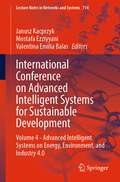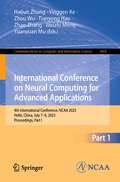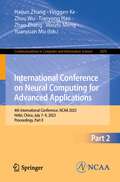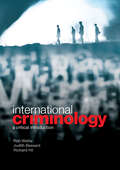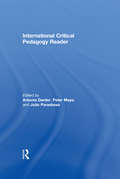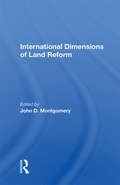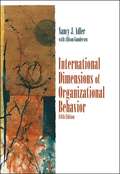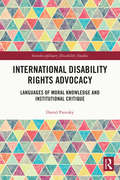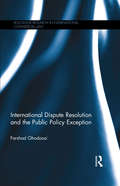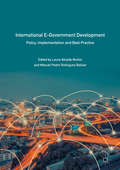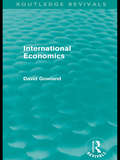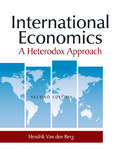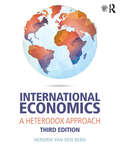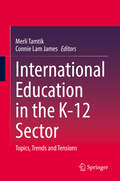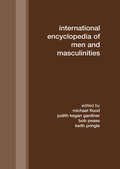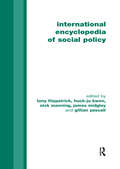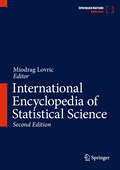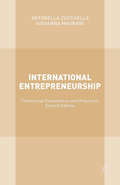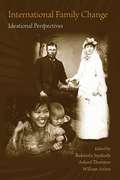- Table View
- List View
International Conference on Advanced Intelligent Systems for Sustainable Development: Volume 4 - Advanced Intelligent Systems on Energy, Environment, and Industry 4.0 (Lecture Notes in Networks and Systems #714)
by Janusz Kacprzyk Valentina Emilia Balas Mostafa EzziyyaniThis book describes the potential contributions of emerging technologies in different fields as well as the opportunities and challenges related to the integration of these technologies in the socio-economic sector. In this book, many latest technologies are addressed, particularly in the fields of computer science and engineering. The expected scientific papers covered state-of-the-art technologies, theoretical concepts, standards, product implementation, ongoing research projects, and innovative applications of Sustainable Development. This new technology highlights, the guiding principle of innovation for harnessing frontier technologies and taking full profit from the current technological revolution to reduce gaps that hold back truly inclusive and sustainable development. The fundamental and specific topics are Big Data Analytics, Wireless sensors, IoT, Geospatial technology, Engineering and Mechanization, Modeling Tools, Risk analytics, and preventive systems.
International Conference on Neural Computing for Advanced Applications: 4th International Conference, NCAA 2023, Hefei, China, July 7–9, 2023, Proceedings, Part I (Communications in Computer and Information Science #1869)
by Haijun Zhang Zhao Zhang Tianyong Hao Weizhi Meng Zhou Wu Yinggen Ke Yuanyuan MuThe two-volume set CCIS 1869 and 1870 constitutes the refereed proceedings of the 4th International Conference on Neural Computing for Advanced Applications, NCAA 2023, held in Hefei, China, in July 2023.The 83 full papers and 1 short paper presented in these proceedings were carefully reviewed and selected from 211 submissions. The papers have been organized in the following topical sections: Neural network (NN) theory, NN-based control systems, neuro-system integration and engineering applications; Machine learning and deep learning for data mining and data-driven applications; Computational intelligence, nature-inspired optimizers, and their engineering applications; Deep learning-driven pattern recognition, computer vision and its industrial applications; Natural language processing, knowledge graphs, recommender systems, and their applications; Neural computing-based fault diagnosis and forecasting, prognostic management, and cyber-physical system security; Sequence learning for spreading dynamics, forecasting, and intelligent techniques against epidemic spreading (2); Applications of Data Mining, Machine Learning and Neural Computing in Language Studies; Computational intelligent Fault Diagnosis and Fault-Tolerant Control, and Their Engineering Applications; and Other Neural computing-related topics.
International Conference on Neural Computing for Advanced Applications: 4th International Conference, NCAA 2023, Hefei, China, July 7–9, 2023, Proceedings, Part II (Communications in Computer and Information Science #1870)
by Haijun Zhang Zhao Zhang Tianyong Hao Weizhi Meng Zhou Wu Yinggen Ke Yuanyuan MuThe two-volume set CCIS 1869 and 1870 constitutes the refereed proceedings of the 4th International Conference on Neural Computing for Advanced Applications, NCAA 2023, held in Hefei, China, in July 2023.The 83 full papers and 1 short paper presented in these proceedings were carefully reviewed and selected from 211 submissions. The papers have been organized in the following topical sections: Neural network (NN) theory, NN-based control systems, neuro-system integration and engineering applications; Machine learning and deep learning for data mining and data-driven applications; Computational intelligence, nature-inspired optimizers, and their engineering applications; Deep learning-driven pattern recognition, computer vision and its industrial applications; Natural language processing, knowledge graphs, recommender systems, and their applications; Neural computing-based fault diagnosis and forecasting, prognostic management, and cyber-physical system security; Sequence learning for spreading dynamics, forecasting, and intelligent techniques against epidemic spreading (2); Applications of Data Mining, Machine Learning and Neural Computing in Language Studies; Computational intelligent Fault Diagnosis and Fault-Tolerant Control, and Their Engineering Applications; and Other Neural computing-related topics.
International Counseling: Case Studies Handbook
by Roy Moodley Uwe P. Gielen Marguerite Lengyell Rosa WuIn this book, designed to increase mental health professionals’ global literacy, authors from 33 countries demonstrate multicultural skills and competencies through case studies that illustrate approaches to counseling and psychotherapy in their countries. Following an introductory section on the use of case studies, chapters focus on a cross section of countries in Africa; Australia and Asia; Central, North, and South America; Europe; and the Middle East. Each case describes the client and his or her presenting concerns and includes a culture-sensitive assessment and treatment plan, an analysis and critical reflection of the case, and questions for discussion. The final chapter of the text presents a comparative analysis of the cases. *Requests for digital versions from the ACA can be found on wiley.com. *To request print copies, please visit the ACA website here. *Reproduction requests for material from books published by ACA should be directed to permissions@counseling.org.
International Courts and Mass Atrocity: Narratives of War and Justice in Croatia (Memory Politics and Transitional Justice)
by Ivor SokolićThe extra-legal effects of international and domestic war crimes trials continue to puzzle researchers and practitioners. In the former Yugoslav states, the legacy of conflict and issues of transitional justice remains central in politics, society and culture. This book provides a new theoretical and methodological approach to one of these puzzles: why universal human rights norms become distorted or undermined when they reach local publics. It investigates the social and cultural contexts that transitional justice processes take place in by looking at how emotional everyday narratives can hamper the spread of norms in society. In Croatia, these narratives define how the public understands the rule of law, history and minority rights.
International Criminology: A Critical Introduction
by Rob Watts Judith Bessant Richard HilInternational Criminology is an easy-access critical introduction to how conventional criminologists in the international arena think about and research crime. By using examples from the US, UK and Australia, the authors outline key ideas, vocabulary, assumptions and findings of the discipline while opening up a set of critical underlying issues and problems. From theoretical traditions to historical perspectives; contemporary criminology to reflexive criminology; this all encompassing text covers it all. This is the most valuable introduction to international criminology available for undergraduates and works as a superb refresher for more experienced students.
International Critical Pedagogy Reader
by Antonia Darder Peter Mayo João Paraskeva<p>Carefully curated to highlight research from more than twenty countries, the International Critical Pedagogy Reader introduces the ways the educational phenomenon that is critical pedagogy are being reinvented and reframed around the world. A collection of essays from both historical and contemporary thinkers coupled with original essays, introduce this school of thought and approach it from a wide variety of cultural, social, and political perspectives. <p>Academics from South America, Europe, Africa, the Middle East, Asia, and North America describe critical pedagogy’s political, ideological, and intellectual foundations, tracing its international evolution and unveiling how key scholars address similar educational challenges in diverse national contexts. Each section links theory to critical classroom practices and includes a list of sources for further reading to expand upon the selections offered in this volume. A robust collection, this reader is a crucial text for teaching and understanding critical pedagogy on a truly international level. </p>
International Deficit Thinking: Educational Thought and Practice
by Richard R. ValenciaInternational Deficit Thinking: Educational Thought and Practice explores the incontrovertible reality of the persistent and pervasive academic achievement gap in many countries between marginalized students (primarily of color) and their economically advantaged White counterparts. For example, International Deficit Thinking discusses the cases of low-socioeconomic Black and Mexican American students in the United States, Indigenous Māori students in New Zealand, and immigrant Moroccan and Turkish pupils in Belgium. The predominant theoretical perspective that has been advanced to explain the school failure of marginalized students is the deficit thinking paradigm—a parsimonious, endogenous, and pseudoscientific model that blames such students as the makers of their own school failure. Deficit thinking asserts that the low academic achievement of many marginalized students is due to their limited intellectual ability, poor academic achievement motivation, and being raised in dysfunctional families and cultures. Drawing from, in part, critical race theory, systemic inequality analysis, and colonialism/postcolonialism, award-winning author and scholar Richard R.Valencia examines deficit thinking in education in 16 countries (e.g., Canada; Peru, Australia; England; India; South Africa). He seeks to (a) document and debunk deficit thinking as an interpretation for school failure of marginalized students; (b) offer scientifically defensible counternarratives for race-, class-, language-, and gender-based differences in academic achievement; (c) provide suggestions for workable and sustainable school reform for marginalized students.
International Dimensions Of Land Reform
by John D MontgomeryLand reform became an international issue in the aftermath of World War II, when the United States planned to dispossess the Junker in Prussia and actually participated in major land redistribution programs in Japan, the Republic of China, and Korea. It became a canon of United States foreign policy in the Philippines, Thailand, and Iran, as
International Dimensions Of Organizational Behavior (Fifth Edition)
by Nancy J. Adler Allison GundersenThe world of organizations is no longer defined by national boundaries. INTERNATIONAL DIMENSIONS OF ORGANIZATIONAL BEHAVIOR breaks down the conceptual, theoretical, and practical boundaries limiting our ability to understand and work with people in countries and cultures around the world. Adler's hallmark approach views global complexity as neither unpredictable nor random; rather, she demonstrates that variations across cultures and their impacts on organizations follow systematic, predictable patterns. The authors' blend of substance and readability--including a wealth of research and examples from around the world--results in a text that is authoritative and richly detailed.
International Disability Rights Advocacy: Languages of Moral Knowledge and Institutional Critique (Interdisciplinary Disability Studies)
by Daniel PateiskyThis book provides insight into the globally interlinked disability rights community and its political efforts today. By analysing what disability rights activism contributes to a global power apparatus of disability-related knowledge, it demonstrates how disability advocacy influences the way we categorise, classify, distribute, manipulate, and therefore transform knowledge. By unpacking the mutually constitutive relations between (practical) moral knowledge of international disability advocates and (formal) disability rights norms that are codified in international treaties such as the UN Convention on the Rights of Persons with Disabilities (CRPD), the author shows that the disability rights movement is largely critical of statements that attempt to streamline it. At the same time, cross-cultural disability rights advocacy requires images of uniformity to stabilise its global legitimacy among international stakeholders and retain a common meta-code that visibly identifies its means and aims. As an epistemic community, disability rights advocates simultaneously rely on and contest the authority of international human rights infrastructure and its language. Proving that disability rights advocates contribute immensely to a global culture that standardises what is considered morally and legally ‘right’ and ‘wrong’, thereby shaping the human body and the body politic, this book will be of interest to all scholars and students of disability studies, sociology of knowledge, legal and linguistic anthropology, social inequality, and social movements.
International Dispute Resolution and the Public Policy Exception (Routledge Research in International Commercial Law)
by Farshad GhodoosiDespite the unprecedented growth of arbitration and other means of ADR in treaties and transnational contracts in recent years, there remains no clearly defined mechanism for control of the system. One of the oldest yet largely marginalized concepts in law is the public policy exception. This doctrine grants discretion to courts to set aside private legal arrangements, including arbitration, which might be considered harmful to the "public". The exceptional and vague nature of the doctrine, along with the strong push of actors in dispute resolution, has transformed it, in certain jurisdictions, to a toothless doctrine. At the international level, the notion of transnational public policy has been devised in order to capture norms that are "truly" transnational and amenable for application in cross-border litigations. Yet, despite the importance of this discussion—a safety valve and a control mechanism for today’s international and domestic international dispute resolution— no major study has ventured to review and analyze it. This book provides a historical, theoretical and practical background on public policy in dispute resolution with a focus on cross-border and transnational disputes. Farshad Ghodoosi argues that courts should adopt a more systemic approach to public policy while rejecting notions such as transnational public policy, which limits the application of those norms with mandatory nature. Contrary to the current trend, the book invites the reader to re-conceptualize the role of public policy, and transnational dispute resolution, in order to have more sustainable, fair and efficient mechanisms for resolving disputes outside of national courts. The book sheds light on one of the most important yet often-neglected control mechanisms of today’s international dispute resolution and will be of particular interest to students and academics in the fields of International Investment Law, International Trade Law, Business and Economics.
International E-Government Development
by Manuel Pedro Rodríguez Bolívar Laura Alcaide MuñozThis book provides an examination of e-Government frameworks and maturity stages in governments around the world, including an overview of the legal frameworks that have supported them. Divided into three sections, the first part of this book analyses the theoretical context of current policies, codes of best practice and their implementation. The second section presents case studies which bring key issues to the fore including open government, privacy protection, social media, democracy, systems failures, innovations in inter-organizational e-government projects, and open data systems. The authors demonstrate the importance of the successful implementation of e-Government for improving managerial efficiency, public service delivery and citizen engagement, with special attention given to developing countries. The book concludes by drawing out the lessons learned from the latest research and recommending solutions for improving the implementation of e-Government in the future, thereby helping to achieve more transparent, participative and democratic societies. This book will provide an invaluable resource for researchers, policy-makers, public managers, international organizations and technical experts.
International Economics (Routledge Revivals Ser.)
by David GowlandMost of the existing textbooks on international economics - a widely taught and ighly popular subject - are long and too detailed and advanced for many students. This book, first published in 1983, and written by a respected leading authority, presents the essentials of the topic in a simple and straightforward way. The book contains the minimum of algebra and avoids detailed proofs. It incorporates the most recent theoretical advances and discusses current issues in comercial policy. Moreover, it puts less emphasis than other textbooks on trade theory and more on balance of payments theory and on questions of international finance and international finance anf international monetarism which are the areas of current concern.
International Economics: A Heterodox Approach
by Hendrik Van BergNow in its third edition, this textbook covers all of the standard topics taught in undergraduate International Economics courses. However, the book is unique in that it presents the key orthodox neoclassical models of international trade and investment, whilst supplementing them with a variety of heterodox approaches. This pluralist approach is intended to give economics students a more realistic understanding of the international economy than standard textbooks can provide.
International Economics: A Heterodox Approach
by Hendrik Van BergNow in its third edition, Hendrik Van den Berg’s International Economics: A Heterodox Approach covers all of the standard topics taught in undergraduate international economics courses. Written in a friendly and approachable style, this new edition is unique in that it presents the key orthodox neoclassical models of international trade and investment, while supplementing them with a variety of heterodox approaches. This pluralist approach is intended to give economics students a more realistic understanding of the international economy than standard textbooks can provide. Changes to the new edition include: updates throughout to reflect recent world events, including coverage of trade negotiations and the Greek crisis; expanded discussion of pluralist approaches with more coverage of alternative schools of thought; discussions of the growing financialization of global economic activity; additional real-world examples; increased coverage of environmental issues; transnational corporations and their behavior in the international economy; the difference between international investment and international finance; and monetary history; a consolidated and updated chapter on international banking. This book also maintains a broad perspective that links economic activity to the social and natural spheres of human activity, with emphasis on the distributional and environmental effects of international trade, investment, finance, and migration. Chapter summaries, key terms and concepts, problems and questions, and a glossary are included in the book. A Student Study Guide and an Instructor’s Manual are available online.
International Education in the K-12 Sector: Topics, Trends and Tensions
by Merli Tamtik Connie Lam JamesThis edited volume focuses on K-12 international education in a global context and examines trends, emerging topics, and prevalent tensions. It considers the rapidly growing phenomenon across a variety of country contexts in a way that can convey both empirical evidence and insights into theorization and practical debates. Contributors touch upon a range of emerging trends in K-12 international education globally, including student mobility, curriculum design, language learning, methodological considerations, and policy considerations through a holistic and comprehensive approach. The book also applies a critical decolonial lens in examining K-12 international education by inviting readers to think critically about issues of power, privilege, equity, and social justice in trying to foster a more informed and socially responsible approach to international education. Ultimately, the book attempts to move beyond a one-size-fits-all approach in order to embrace the complexity of issues that emerge from international education involving vulnerable populations. The book is grounded in institutional theory, which allows to explore the complex web of institutional norms, values, and behaviors that are shaping the experiences through international education across the different chapters in this volume. As an edited volume, authored by academic experts and practitioners from around the world, this book provides the most recent and up-to-date account on documenting developments related to K-12 international education internationally. Through contributing significant evidence across international contexts, the book raises new questions and offers new perspectives to the field, opening conversations both within and across governments and non-governmental stakeholders such as educators, students and parents.
International Empirical Studies on Religion and Socioeconomic Human Rights (Religion and Human Rights #5)
by Hans-Georg ZiebertzSocioeconomic rights include rights with regard to social security, labour and employment, as well as cultural rights which may be regarded as a shield for the protection of human dignity, especially of specific groups, such as women, children and refugees. The enforceability of socioeconomic rights clearly distinguishes them from other rights. These rights need, perhaps more than others, the support of civil society. Because states have leeway in how resources are distributed, civil society has a major impact on what resources are used to fulfil socio-economic rights. One of the actors in the public arena are religious traditions, respective Churches. Most of them have developed ethical standards for individual conduct and rules for living together in society based on their basic scriptures. All three monotheistic religions, Judaism, Christianity, and Islam, are marked by a caring engagement for the poor, the sick, the old and the foreign. From an empirical perspective, the general research question of this volume is how young people understand and evaluate socioeconomic rights and to which degree religious convictions and practices are connected with attitudes towards these human rights. Can religion be identified as a force supporting the human rights regime and which additional concepts strengthen or weaken the consent to these rights? The richness of empirical data contributes to a better understanding how socioeconomic rights are legitimated in the opinion of more than 10.000 respondents in 14 countries.
International Encyclopedia of Economic Sociology
by Jens Beckert Milan ZafirovskiThe International Encyclopedia of Economic Sociology is the first encyclopedia in the field and a timely response to the surge of interest in economic sociology over the last 30 years. Economic Sociology deals with the multiple and complex relations between economy and society. In particular, it focuses on the impact of social, political and cultur
International Encyclopedia of Men and Masculinities
by Bob Pease Keith Pringle Michael Flood Judith Kegan GardinerThe International Encyclopedia of Men and Masculinities offers a comprehensive guide to the current state of scholarship about men, masculinities, and gender around the world. The Encyclopedia's coverage is comprehensive across three dimensions: areas of personal and social life, academic disciplines, and cultural and historical contexts and formations. The Encyclopedia: examines every area of men's personal and social lives as shaped by gender covers masculinity politics, the men's groups and movements that have tried to change men's roles presents entries on working with particular groups of boys or men, from male patients to men in prison incorporates cross-disciplinary perspectives on and examinations of men, gender and gender relations gives comprehensive coverage of diverse cultural and historical formations of masculinity and the bodies of scholarship that have documented them. The Encyclopedia of Men and Masculinities is composed of over 350 free-standing entries written from their individual perspectives by eminent scholars in their fields. Entries are organized alphabetically for general ease of access but also listed thematically at the front of the encyclopedia, for the convenience of readers with specific areas of interest.
International Encyclopedia of Social Policy: 3-volume Set
by James Midgley Huck-Ju Kwon Gillian Pascall Nick Manning Tony FitzpatrickAvailable in paperback for the first time, this milestone work offers an in-depth treatment of all aspects of the discipline and practice of social policy globally. Supported by a distinguished international advisory board, the editors have compiled almost 900,000 words across 734 entries written by 284 leading specialists to provide authoritative coverage of concepts, policy actors, welfare institutions and services along a series of national, regional and transnational dimensions. Also included are biographical entries on major policy makers and shapers. The editors have particularly striven to provide strong coverage of differing geographical and cultural traditions so that the variety of social policy, as both an academic discipline and a domain of governance, is reflected. Contributors draw in and make the necessary connections with social policy's associated disciplines to provide a rich picture of this vast and highly diverse field. Comprehensive and authoritative, the Encyclopedia has sought to open up rather than to foreclose the numerous areas in which there is on-going research, debate and, sometimes, serious disagreement and divergence in theory and practice. To this end, entries attempt to introduce a core or common ground of understanding before moving on to a wider discussion of debates regarding different conceptual and geographical approaches. The whole is integrated by cross-referencing and each entry includes a bibliography for further reading. There is a full index. The International Encyclopedia of Social Policy provides the most substantial mapping of the international study and practice of social policy to date and will stand as a vital storehouse of knowledge for many years to come.
International Encyclopedia of Statistical Science
by Miodrag LovricThe International Encyclopedia of Statistical Science stands as a monumental effort to enrich statistics education globally, particularly in regions facing educational challenges. By amalgamating the expertise of over 700 authors from 110 countries, including Nobel Laureates and presidents of statistical societies, it offers an unparalleled resource for readers worldwide. This encyclopedia is not just a collection of entries; it is a concerted effort to revive statistics as a vibrant, critical field of study and application. Providing a comprehensive and accessible account of statistical terms, methods, and applications, it enables readers to gain a quick insight into the subject, regardless of their background. This work serves to refresh and expand the knowledge of researchers, managers, and practitioners, highlighting the relevance and applicability of statistics across various fields, from economics and business to healthcare and public policy. Furthermore, it aims to inspire students by demonstrating the significance of statistics in solving real-world problems, thus encouraging a new generation to explore and contribute to the field.
International Entrepreneurship: Theoretical Foundations and Practices; Second Edition (The\mcgill International Entrepreneurship Ser.)
by Antonella Zucchella Giovanna MagnaniOver the past two decades international entrepreneurship has become a key issue in international business studies. This second edition of International Entrepreneurship examines this key emerging issue from its foundations; entrepreneurship, strategic management and international business studies. The book proposes an integrated interpretive framework in which to place international entrepreneurship, examining both theoretical and practical interests. It asserts that firms faced by global competitive pressures need to develop proactive and innovative responses to cope with the uncertainties of international markets and instead capture the opportunities. This book presents a common framework to complement the growing contributions to this topical and lively subject.
International Express: New Yorkers on the 7 Train
by William Kornblum Stéphane TonnelatNicknamed the International Express, the New York City Transit Authority 7 subway line runs through a highly diverse series of ethnic and immigrant neighborhoods in Queens. People from Andean South America, Central America, China, India, Italy, Korea, Mexico, Pakistan, Poland, Romania, and Vietnam, as well as residents of a number of gentrifying blue-collar and industrial neighborhoods, fill the busy streets around the stations. The 7 train is a microcosm of a specifically urban, New York experience, in which individuals from a variety of cultures and social classes are forced to interact and get along with one another. For newcomers to the city, mastery of life in the subway space is a step toward assimilation into their new home.In International Express, the French ethnographer Stéphane Tonnelat and his collaborator William Kornblum, a native New Yorker, ride the 7 subway line to better understand the intricacies of this phenomenon. They also ask a group of students with immigrant backgrounds to keep diaries of their daily rides on the 7 train. What develops over time, they find, is a set of shared subway competences leading to a practical cosmopolitanism among riders, including immigrants and their children, that changes their personal values and attitudes toward others in small, subtle ways. This growing civility helps newcomers feel at home in an alien city and builds what the authors call a "situational community in transit." Yet riding the subway can be problematic, especially for women and teenagers. Tonnelat and Kornblum pay particular attention to gender and age relations on the 7 train. Their portrait of integrated mass transit, including a discussion of the relationship between urban density and diversity, is invaluable for social scientists and urban planners eager to enhance the cooperative experience of city living for immigrants and ease the process of cultural transition.
International Family Change: Ideational Perspectives
by Arland Thornton Rukmalie Jayakody William AxinnMany dimensions of family life have changed. Age at marriage has risen, arranged marriages and extended families have declined, intergenerational relationships have been altered, and contraceptive usage has become widespread. Until now, most explanations have focused on structural influences that emphasize changes in social and economic circumstanc
